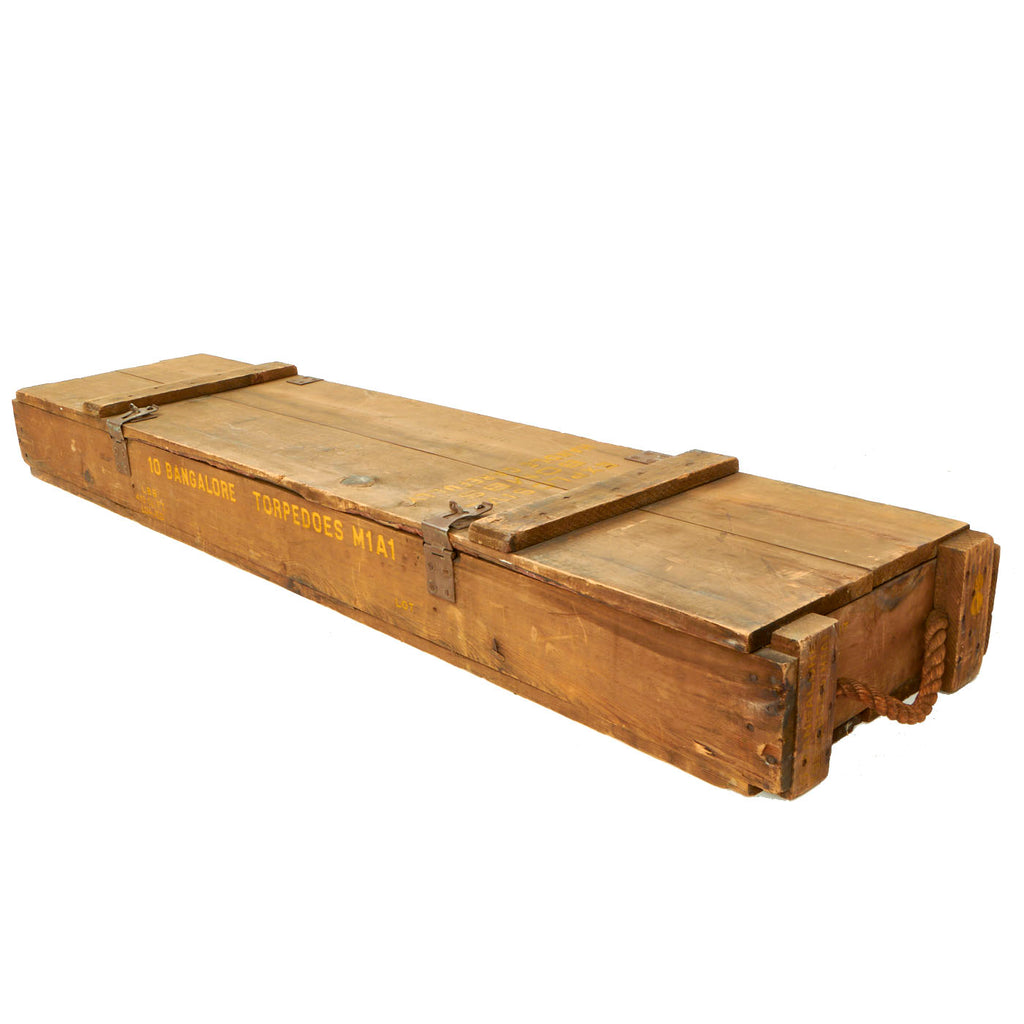Item Description
Original Item: Only one available. This is incredibly scarce U.S. WWII Era Transit Chest for ten "Bangalore Torpedos", which are linear explosive charges inside a metal tube. Used by combat engineers / pioneers in the field, these can quickly clear wire, fence, concentrated brush, and other obstacles out of the way in preparation for an offensive. They usually are able to clear a 3-4m wide path in their modern forms.
The version fielded by the United States during WWII was about 5 feet long, and termed the "M1A1". This lovely chest is marked on the side in yellow with:
10 BANGALORE TORPEDOS M1A1
This is also stenciled onto both ends, along with the U.S. Ordnance "Flaming Bomb." There originally would have been racks or spacers on the interior to stabilize the devices, but these are not present in this transit chest. The chest is in very good condition, with crisp markings and remaining natural colored wood. The chest measures 64 1/2" x 15 1/2" x 7 3/4".
Original examples of these crates are very hard to find, as they were large and almost always broken down after use. Ready to add to your collection!
A Bangalore torpedo is an explosive charge placed within one or several connected tubes. It is used by combat engineers to clear obstacles that would otherwise require them to approach directly, possibly under fire. It is sometimes colloquially referred to as a "Bangalore mine", "banger" or simply "Bangalore".
The Bangalore torpedo was first devised by Captain R. L. McClintock, of the Royal Engineers while attached to the Madras Sappers and Miners unit of the Indian Army at Bangalore, India, in 1912. He invented it as a means of blowing up booby traps and barricades left over from the Second Boer War and the Russo-Japanese War. The Bangalore torpedo could be exploded over a mine without a sapper having to approach closer than about 3 m (10 ft).
The design quickly spread worldwide to Pioneer troops as a very effective way for clearing obstacles, whether they be mines, barbed wire, or other installed field obstacles.
The Bangalore was adopted by the U.S. Army during World War II as the "M1A1 Bangalore torpedo". Bangalore torpedoes were packed in wooden crates that contained 10 torpedo sections, 10 connecting sleeves, and 1 nose sleeve; the total weight of a crate was 176 pounds (80 kg). Each torpedo section was 5 feet (1.5 m) long, 2.125 inches (54 mm) in diameter, and weighed 13 pounds (5.9 kg). Each end of the torpedo was filled with 4 inches (102 mm) of TNT booster, while the middle section contained an 80-20 amatol mixture; the explosive charge weighed about 9 pounds (4.1 kg). Each end of the torpedo had a recess to accommodate a standard Corps of Engineers blasting cap. Torpedo sections could be attached together via spring clip-equipped connecting sleeves, and a blunt nose sleeve was provided so that the assembled torpedoes could be pushed through obstacles or across terrain without getting stuck.
It was widely used by the U.S. Army, notably during the D-Day landings. The Bangalore torpedo was obsolete in British use at the time of D-Day, having been replaced by rocket-launched Congers and Armoured Vehicle Royal Engineers (AVRE) vehicles equipped with a 40-pound (18 kg) explosive charge for bunker clearing.
- This product is not available for international shipping.
- This item is completely legal within the USA. International Military Antiques, Inc observes all Federal, State and Local laws. Everything for sale on ima-usa.com is completely legal to own, trade, transport and sell within the United States of America. Every display machinegun and machine gun parts set and gun sold by IMA, Inc is engineered to be inoperable according to guidelines provided by the US Bureau of Alcohol, Tobacco, Firearms and Explosives (BATF).
- Eligible for all payments - Visa, Mastercard, Discover, AMEX, Paypal & Sezzle












